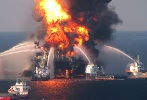
BP Sues Owners of Drilling Rig, Blowout Preventer
On the first anniversary of the Deepwater Horizon explosion, the oil company sued Transocean and Cameron International Corp. The Chemical Safety Board's chairman said its investigation has been slowed because "companies and witnesses [are] evading subpoenas for testimony and records."
The first anniversary of the explosion aboard the Deepwater Horizon drilling rig off the Louisiana coast was a busy day, with Macondo well owner BP suing the rig's owner, Transocean, as well as Cameron International Corp., which made the blowout preventer that failed to prevent a major oil spill. PBS NewsHour aired a report by Correspondent Tom Bearden examining the continuing battle over compensation for losses sustained because of the oil spill. In later reports, he will look at residents' opinions about BP and the government and at long-term environmental and health consequences. His first report about links between the oil spill and erosion was broadcast April 15.
Other materials available at the channel's page including interviews, a timeline, and an update with Deepwater Horizon rig survivor Chris Choy.
Posted on BP's homepage were a movie about the Gulf Coast region's recovery, a report on its redoubled safety efforts in the wake of the explosion, and a statement by Chief Executive Bob Dudley, who replaced the man in charge of BP on April 20, 2010, Tony Hayward. "Today marks the first anniversary of the tragic accident on the Deepwater Horizon oil rig in the Gulf of Mexico," Dudley's statement said. "Eleven men died in the accident and our thoughts are with their families, friends and colleagues particularly today. We also remember those who were injured and affected in other ways by the accident and the subsequent oil spill. We are committed to meet our obligations to those affected by this tragedy and we will continue our work to strengthen safety and risk management across BP. But most of all today, we remember 11 fellow workers and we deeply regret the loss of their lives."
There was no report about the lawsuits among news releases on BP's website or on its investor relations page. Bloomberg News and many other news outlets reported it. Transocean posted a statement on its website April 21 in response to the lawsuit, saying in part, "Under the drilling contract for Deepwater Horizon, BP has agreed, among other things, to assume full responsibility for and defend, release and indemnify Transocean from any loss, expense, claim, fine, penalty or liability for pollution or contamination, including control and removal thereof, arising out of or connected with operations under the contract. Transocean expects BP to honor its contractual indemnification obligations under the contract. The Deepwater Horizon drilling contract with BP can be found in the company's August 4, 2010 10Q filing with the SEC."
The U.S. Chemical Safety Board's chairman, Dr. Rafael Moure-Eraso, released a statement in which he remembered the 11 workers who were killed and expressed condolences for their families and co-workers. He added that CSB's investigation of the accident, which began in June 2010, "continues to examine a number of critical offshore oil and gas process safety issues. Currently CSB investigators are focusing on evaluating physical evidence, including participating in the first phase of the blowout preventer testing. The CSB continues to face significant challenges in its fact-gathering process including companies and witnesses evading subpoenas for testimony and records and the lack of effective coordination amongst the various organizations involved in the investigation."
He said CSB investigators are assessing the offshore safety regulatory regime in place when the Deepwater Horizon sank by interviewing personnel from the former Minerals Management Service and industry regulatory specialists. They are also reviewing new regulations and recent changes installed by the new safety regulator, the Bureau of Ocean Energy, Management, Regulation, and Enforcement.